We can’t put out a statement saying, “Anyone in this zip code…. will need to replace all plants.” Or vice versa, “Anyone in this zip code… all your plants will be fine.” Both those statements would be untrue. See those two pictures of the same variety of salvia planted in two different areas of my yard. The second one has new growth, totally unscathed by the freeze, and the first one looks dead top to bottom. Will it come back from the roots once the weather warms completely? I’ll have to let you know. Every year it has so far, but this year was like no other.
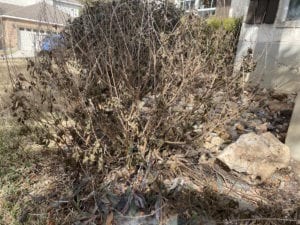

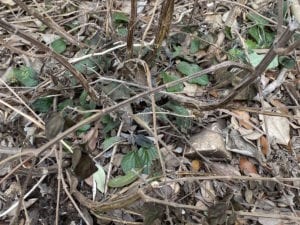

The extent of freeze damage has many variables. Some variables that would make freeze damage more prevalent are:
- Was your plant recently planted?
- Did you prune before the freeze and already have new growth?
- Were your plants tropical to subtropical?
- Were your plants succulents?
- Did your fruit trees already have flowers. (Your tree could be fine, but you might not get fruit this year.)
- Did you forget to take all precautions to protect plants with frost cloth, blankets, heating lamps, etc….
- Did you remember to tell your plants you loved them and you wanted to see them on the other side of this freeze?
Seriously though, we know it’s hard when you lose your beloved plants, and we’re Texans…we are ready for our spring gardening season! Our best advice with this recent freeze is to use these guidelines, and that’s all they are, to assess freeze damage in your plants and to help figure out what to do next.
What to do with your plants after the freeze.
Freeze damage usually makes plant material look dark, with a water soaked appearance. The black color of the plant material turns to brown and then dries. Gross! Now what?
Native plants and zone 8 perennials and shrubs might start generating new growth within the next few weeks if the weather continues to warm.
Plants that love the hot weather (think Pride of Barbados, Duranta, FireCracker Fern, etc…) will take much longer to reach out from their roots.
This will be one of the harder things to do because we’re going from day temperatures of 19° to 70 in a matter of days. It blows our minds and we want to be planting. If you have plants you love in your landscape, wait, and give them time to come back.
2. Wait! Don’t be so hasty to prune freeze damaged plants.
Yes, freeze damaged plants are UGLY, but if you can stand the ugly for a little while longer, it can help protect the rest of the plant is there is another….I don’t want to say it….late freeze! Sorry, but the truth is weather is unpredictable, and the groundhog did say 6 more weeks of winter.
You can clearly see the freeze damage in the first close up picture of plumbago. Can you see the healthy plant material underneath the freeze damage in the second picture? Waiting to prune until warmer weather when new growth starts to develop also helps you know where you should make your cuts when it is time to prune.
When you do prune in a few weeks, make selective cuts. Start at the farthest part of branches, limbs and stems, and make gradual cuts until you hit fresh plant material.
* While you are being patient with your plants, please also be patient with us. Both locations, 5 plus acres, also went through the freeze with you. While a huge effort went in to protect our plant material, we lost some too. Deliveries are on the way, but everyone’s schedules are mixed up. We are working diligently to get you plant material as quickly as possible to replace your losses from the freeze.
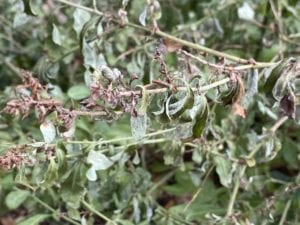

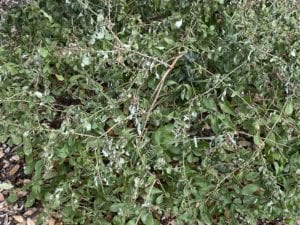

3. Wait a few days after the freeze to assess plants.
Assess if a plant has been freeze damaged by using a knife or your fingernail to gently scrape back bark on a branch. Check for healthy plant tissue that will look light cream to green in color. Then go back to guideline #2 and Wait.
4. Wait to fertilize, but offer normal amounts of water (don’t go overboard).
You don’t need to fertilize and push new growth just yet. Let’s make sure we are out of the woods with the cold snaps. Water, however, can help plants recover. Check the soil around your damaged plants like you normally would. (Stick in finger 2 inches to feel for moisture.) If dry, water normally. Don’t think that dumping a ton of water on your plants is servicing them. No need to overwater, just resume a regular water schedule.
5. Wait and decide if you even want the freeze damaged plant.
No need to run out to the nursery to buy another plant to replace the exact species if you don’t really think you like it much. Not to be heartless, but there were a couple of plants in my landscape that I was happy to say, “Good Riddance!” They were plants that caused me angst on a regular basis, so when the freeze took them on and won, I didn’t care. (You might be able to see in the pics below why I didn’t shed any tears for the freeze damaged fig ivy that was overstaying its welcome.)
If you know you don’t care much about the plant, it’s damaged anyways and you just don’t want to wait to get rid of it, THEN you can yank it out. You only need to fight the wait for those plants you truly love. Maybe you can replace the jilted plant with a beautiful native that is more apt to beat the weather odds anyways.
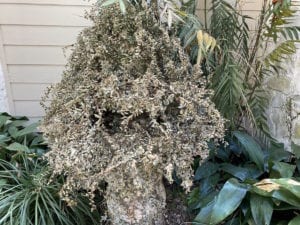

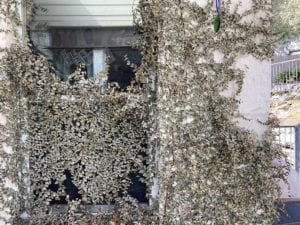

1. Research New Plants.
Take a look at our Plant Finder tool that is located on our Learning Center page. While the plants listed in the plantfinder tool are not necessarily indicitive of what we have in stock at the current time, they are plants we generally carry or have carried before.
Our Plant Finder tool is great for researching plants you are thinking of incorporating into your landscape. It’s a great way to make a wish list that you can then cross reference with our plants at Rainbow Gardens.
Maybe one of your freeze damaged plants had been around for years and you never got around feeding the soil. Don’t pull out a plant and plop a new one in its place before making sure the soil is healthy and ready to offer your new plant an amazing home.
3. Take a moment to mourn your plants if you need to, then take a deep breath and think warm thoughts of spring. It is still coming.
If you do need to replace some of your plants, know that we are here for you. It’s also a great time to plant in early spring. We’ll keep offering up tips to help you through this; right now, try and be patient with your plants and wait. Before you know it, it will be the heat that we battle instead of the cold! Best of luck!
~The Happy Gardener, Lisa Mulroy

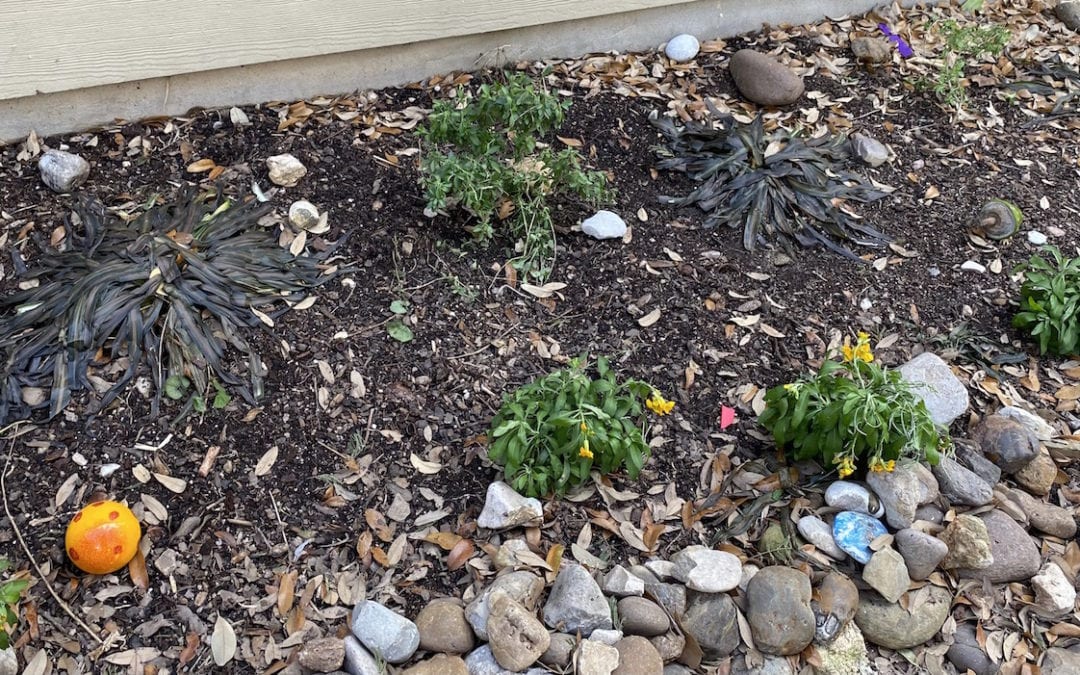
I planted two apple trees and a peach a week before the freeze, also three Xylosa bushes. They look awful. Is there a chance they might survive being new plantings? Thank you
Hi Susan,
It will all depend on how you protected them. Were they watered well before the freeze? Did you mulch them, including piling mulch up against the trunk for the duration of the freeze? Hopefully you read the blog you posted on with our tips to look for fresh plant material on the limbs and branches. If your fruit trees had flowers before the freeze, it’s possible you might not get fruit this year, but that the trees themselves could survive if you protected them. It’s a bit of a waiting game right now. Give them a few weeks to a month to really be able to see the extent of the damage. Keep them normally watered for the time being.
I have two very large Texas Sage that are 15 years old. I have been patient but no sign of new leaves on any of the limbs. On one of the bushes, There are lots of tiny new leaves on the main trunk almost at the ground. Should we prune all the limbs off and hope these tiny leaves will produce some sort of limb? I’ve never seen this and am wondering if we should entirely remove the bushes. I’m just sick….they were both beautiful stand alone specimens.
Hi Debbie,
We advise cutting back the entire plant to about 12″ high. I know, I know, this isn’t what you really want to hear, and I’m so sorry. They sound like they are coming back, but it will be kind of like starting with new plants. Their roots are probably sound, so cut them back, and the plus side is that they will start coming in nice and full. It will just take them awhile to get back to their height. If you can wait for that, don’t pull them out. If you need bigger, taller plants right away, you might want to replace. If it were me, I’d leave them and allow them to grow. you may just appreciate them even more than you already did because they survived!
Cut them back.
My tangerine tree is 10 years old and over 8 tall. So it is too big for me to cover. Now the top branches and leaves are brown and side branches are losing leaves. How do I save it?
Betty,
Wait for a month or possibly longer to be able to see the extent of the damage. Then, when your citrus starts to leaf out and show new growth, you will be able to clearly see where to prune to. Only prune back to the new, green growth….but wait… give your citrus time to regenerate. Losing the leaves is normal in this case of severe weather. Water normally and don’t fertilize yet. We aren’t out of the woods yet, as we could see another freeze (not to the extent that we just had, but we can still get bit). Hope this helps….
I have always trimmed my Blenda Dream rose in February. With this freeze, I am not sure what to do. It is 20 years old. I also have an old rose that is about 5 years old. Any guidance you can give me will be greatly appreciated I look forward to getting back to your Thousand Oaks location and refilling my pots.
You can trim back your roses in a week or so to make sure we are out of the woods for anymore late freezes. Some people have opted to prune now and just know that if we get a late freeze, you will need to make extra sure the roses are completely protected, or new growth will suffer. Water normally now, and mid March you can start your fertilizing program. Please see our youtube channel where we recently posted some videos on rose pruning and care.
My citrus trees were covered and protected but got hit anyway!
How long should I wait to prune back”burnt” growth?
Hi Kat,
You aren’t going to like hearing this, but I wouldn’t touch your citrus trees for at least a month, maybe longer. This way you will really be able to see the extent of the damage. Wait, wait, wait. Give you citrus time to rejuvenate themselves. You are waiting for your citrus to start to leaf out some to show you new growth, and then prune back to that point. Until then, water normally, don’t fertilize.
What should we do with our sago palms, almost every other house has a sago palm or two and the palms are all brown?
Hi Tammee,
Our best advise is to wait out the brown for awhile and allow some time to clearly see the damage. If you can’t stand the brown, you can remove the damaged fronds of the palm, but do not ever cut into the center of the plant. Like, don’t just hack off the top. All new growth on palms originate from the that center so you need to leave that intact when you are pruning. Remove outer fronds that are obviously lifeless, and then, wait….for warm weather to rejuvenate your sago. The wait may be longer than normal, but probably in a few (3) weeks or so you should start seeing new growth if it is going to happen. Remember that we could still have another freeze, so anything cut back will need extra care and protection if so.
My Sago palm got hit as well. It is small and was planted about 6 months ago. It looks bad, but I will wait before I pull it out completely. Thank you for this blog and for the extra advise.
Absolutely! Let’s give it some time and see what turns up. It can be surprising what survives if you give it a little time to peek out.
Thank you for the information and encouragement, will watch, wait, then be sure to replace anything I need from Rainbow.
Thank you, Jo!
It’s the hardest thing for us gardeners to when spring is knocking at the door. We also have a spring clean up blog for when the wait is over and we can get busy again. Thank you so much for reading and good luck!
Is there any hope for my Aloe Vera plants that look like jelly?How about my Boston Fern? 😢Thanks
Hi Kathy,
Aloe vera are not one of our best cold hardy plants, however, it might come back depending on the age of it and how it was protected. As far as the jelly-like, mushy leaves, cut those off now. The mushy plant material can invite fungal disease. trim off all those parts and…..wait. We don’t advise pulling out anything yet, it’s still too early to tell. If you can’t stand the look of the dead fronds of your Boston fern, you can trim back the outer layers a little to clean it up some, BUT, we could still get a freeze, and you’ll need to cover and protect again. New fronds could start peaking out of the center in a few weeks, but we’ll have to wait and see. I leave mine alone until I can clearly see the damage.Those dried outer fronds could still add a layer of protection to the new growth if we do in fact get another freeze.
I planted Cannas and mums last spring. They are damage due to the freeze. Can they survive a freeze? How do I improve Their chances?
It depends on the efforts your took to protect them and the severity of the damage they endured, which you might not know for a couple of weeks. If the tissue of your cannas is oozy or slimy (mush) trim that part of now. This plant material can develop fungal issues. You’ll need to wait to to see if they come back once the weather warms up. Mums will generally come back, If you can clearly see the difference between the damaged area and healthy material, gently work your way from the top of the plant and prune down until you reach a healthy part of the limb (lt. cream to green material). Just know that it’s possible we could still get another freeze and these plants will need to be protected again. Waiting a couple of weeks to be able to clearly see freeze damage is advised. (Except for the mushy parts if any on your canna.)
First, THANK YOU for allowing us to ask questions! I have/had 2 Cactus Opuntia Purple bought at your nursery in September 2020. They were turning purple and starting to get those cute little buds. I see their ‘ears’ as I call them, have fallen over; no longer upright, but still attached to the main stem, and they are soft to the touch. I have let them lay as I pray they might recover. Are they finished, should I pull out the entire cactus and replace?
It might come back depending on how it was protected. As far as the jelly-like, mushy leaves, cut those off now. The mushy plant material can invite fungal disease. trim off all those outside parts and…..wait and see in a few weeks what the base of the plant looks like. It the main stem becomes mushy, it most likely will need to be replaced.
This is not directly related to the freeze issue- but 20 some years ago, in the spring, the new leaves of many live oaks where I worked were eaten up by webworms by 50%- to 75%. It looked really bad. But before too long, the trees leafed out again. It’s great to see how plants can often endure damage like that, or freezing.
Absolutely! Plants can be extremely resilient. P.s. see our blog on webworms for some tips to keep them from completely defoliating your tree again. Thanks for reading!
Will my Cactus Opuntia Purple purchased last September come back? Both have ‘ears’ fallen over but still attached to main base. THANK YOU!
They might come back depending on how it was protected. As far as the jelly-like, mushy leaves, cut those off now. The mushy plant material can invite fungal disease. trim off all those outside parts and…..wait and see in a few weeks what the base of the plant looks like. It the main stem becomes mushy, it most likely will need to be replaced.
I planted some prickly pear about 6 months ago, all the “leaves” are sagging and yellow and when I push on the “trunk”it’s mush. I I know they’re usually pretty resilient but can’t help but feel like they’re gonners. Especially since across the street, theirs is just dropping the leaves off.
Cut all parts that are mushy. You may need to cut down to the ground. Yes, they are pretty resilient plants, but the duration of the storm was that to cause extensive damage. They may need to be replaced, but we still advise to leave the base in the ground for a few weeks (but cut off the mush) to see what happens.
What about a my beautiful and very large yellow butterfly vine? It’s completely brown. How to I best care for it?
Same way as advised for most plants. You will soon be able to see a clear difference where the brown material meets green if your vine will survive. In a couple weeks, you can begin to trim back beginning from the most distal ends until you meet healthy, new growth. If you don’t find any, you might need to replace. For the time being, just water normally until warm weather shows new growth or not.
I did prune before the freeze as I had plenty of new growth on my Pink Skullcaps, Dwarf Ruellia, and Mexican Butterfly Weed. I’m fairly certain the Butterfuly will come through, but the Ruellia and Skullcaps I question. I know when we planted last year the Ruellia we were told we can’t kill them, I wonder now? What should I do, sit back and wait a few weeks as you have written about above? Or, am I doomed and need to replant?
Not doomed, but you do need to wait and see, or you may end up pulling out plants that were just waiting for warm weather to regenerate. The duration of the low temperatures from the storm was so unique that many plants that are normally hardy and “unkillable” will meet their demise. Remove any slimy or mushy foliage from dwarf ruellia so that fungus isn’t developed, and wait. Your plants come back from their rhizomes, and roots so warm weather could possibly bring them back up. You’ll be able to see damage clearer in a couple of weeks and will see more obviously where to prune.
I had just trimmed my older rose bushes (all but one was over 10 years old) the week before the freeze. They all look pretty bad and some have black stems already. How long should I wait to see if they will pull through.
Roses take off pretty fast once warm weather begins to be present more consistently. A few weeks should show more clearly where the damage ends and new growth starts. Then, you can prune back the dead material to the healthy material and start your fertilizing program. Wait for the warmth, wait for your roses to have a shot at rejuvenating.
Parts of my yard were devastated by the freeze. What do you recommend for Primrose Jasmine, Bayonet Yucca and Chinese Palm. Also the leaves are slowly browning and drooping on the Loquat trees—will they come back?
Franze,
Sorry to hear your freeze news. Know that we are all suffering with you. You’ll just have to be on the lookout for new growth emerging from all of these plants, but we need longer time with warm weather for that to happen. We are really starting to notice the damage now as the plant material dries up and browns after the freeze. With yucca and palm, make sure you don’t cut into the middle of the plants as that is where new growth will generate from. If you want to clean up the outside fronds you can, but know if we get another late freeze you need to take precautions and protect. Water normally (not over water) and give them all some more time with the warmth of the sun. You’ll be able to see more clearly in a week or two where you can prune back to healthy plant material if there is some.
Can you tell me if my pittosporum will come back? I have very large ones and dwarf ones . The dwarf ones have list all their leaves.
Aldo I have a well established jasmine vine that completely covers my wrought iron fence and gives h my e complete privacy from my neighbors house. It is completely brown. Should I wait to B see if it will come back or just tear out . I need to have the privacy between the yards.
Hi Louise,
You will have to wait to see. It’s a bit too early to really know how much plants have suffered from the damage. You can trim off the brown leaves from your pittosporum, but wait until you can see new growth on the limbs, or the difference on the limbs between healthy material and dead before pruning. You will also have to wait to see if your vine will come back. Look for new shoots towards the root area. You might find you will have to trim it all the way to the ground, but you still need to give it more time. It could take a while to come back and to completely cover your fence, so if you can’t wait and give it time to fill in this year from the ground, you might need to think about planting a larger one. The vine will not flower this year either.
Our entire home is covered with fig ivy. All the leaves are dead from the freeze. Do you know if the vines will be able to regenerate new leaves, or do we need to cut back all the ivy to the ground level?
Hi Tim,
Fig Ivy can actually come back on the vines…but it can also sprout from the ground. can you give it a couple more weeks? Keep looking closely for signs of tiny leaf buds swelling and you might not have to cut it all down. If the vine is brittle and snaps easily, you can start to remove it gradually, looking for healthier, flexible plant material in the vines as you prune. It is kind of up in the air, depending on if there was nay protection from the storm (large trees, certain sides of the house having more protection, etc…) Hope this helps a little. Hang in there.
What are your thoughts on how loquats fared with the freeze? We have several large mature loquats (15 – 20 feet). Most of their leaves have turned brown and are dropping. There are still some green leaves interspersed with the brown. What pruning, if any should be done?
Thank you.
Hi Lori,
The fact that your loquats are mature and you still have some green leaves should give you a little hope. Wouldn’t prune until you can see a definite stop of new growth on the limbs. Allow the brown leaves to continue to drop and you will be able to start to see if there are new buds swelling along the limbs easier. Only prune obviously broken limbs for now and allow the tree to try to rejuvenate. Don’t count on fruit this year though.
Thank you!
Absolutely!
My big purple sage bushes look dead. Is there still hope?
Hi Sandra,
I’m not sure how they were protected if they were, but generally, perennials in the sage family should have started to show some signs of life if they are coming back. Have you really gotten down to look at the roots to see if any new life is sprouting? If limbs are snapping when slightly bent and there is no sign of green or light cream tissue, it’s possible you may need to replant. I won’t be able to tell you for sure, as you will need to do the assessing, but we can offer these bits of advice to guide you. I’m also not sure if you mean Texas Sage (Cenizo), or a type of salvia sage.
Help! My nectarine came of out of dormancy before the snow and now all the leaves and blooms are brown and crunchy. I haven’t touched it or cut it back but i see new blooms emerging from the trunk.. I don’t know what to do. I also have a orange trees that are blooming from the trunk and pomegranate do I just let them do their thing?
Hi Joann,
Yes, let them do their thing through spring. It is advisable not to prune until spring growth has commences. Offer water and fertilizer to help rejuvenate your citrus, but hold off on cutting anything back just yet. Please see this helpful article from TAMU: https://aggie-horticulture.tamu.edu/newsletters/hortupdate/2010/jan_feb/CitrusFreeze.html
I am in Austin, my celeste fig tree is now growing from the very bottom as well as from the very top …it is about 10 years old and maybe 15 feet tall? it has been a great producer.
All the middle branches appear to be dead although it looks like there might have been a little growth on the tips of the branches. Should I just leave it alone and see what happens? Please adviice. Thanks so much!
Hi Belia,
If you see growth appearing at the tips, I don’t think those branches are dead. There wouldn’t be growth at the distal part of branch if it was totally dead. Can you give it a little fertilizer and a week or two more to check for additional growth on the ends of the branches?
I’ve got a mature Sotol & after the big freeze, some of the fronds at the top were green but they started turning brown. It’s impossible to trim off the sharp points fronds off of 2 separate stalls 10 ft. high.
I decided to cut back the stalks that are about 6″ in dia. about 2 ft. above the main trunk. I spell a rotting smell near it & I’ve not seen any new growth yet 2 mo. after initially cutting the tops off. Should I cut off another 2 ft. of the 2 stalks to see fresh tissue?
Should I apply some liquid fertilizer mixed with water, please?
Hi Chuck,
Unfortunately it does not sound like your Sotol will be coming bak. That rotting smell is a big indicator. I don’t think fertilizer will do much to help. You can try cutting back the stalks, but I think the damage is further into the plant. You may need to look at a replacement. I feel your pain!
After the Big Freeze, I am concerned with the return of my monstera philodendron in a pot. It is over 50 years old and has not put out any new stems.
Dolores,
Unfortunately, by this time you would have probably seen some new growth on the plant if it is to come back. Plants that were in pots and left out were more susceptible to damage during the Big Freeze. Have you already cut it down to it’s base? What is the texture of the remaining parts of the plant? We’ve still had quite a few cooler days, and it may just need some extra warmth, but I’m not sure if that’s the case. You can try cutting it down to it’s base, offering it some fertilizer and placing it in the warmest area you can find in your landscape and see if that invokes some life.
Our mature pomegranate trees were severely damaged by the big freeze. Only two of the six limbs survived on one tree and all of the big limbs appear to be dead on the other. However, there are numerous sprouts appearing from the roots of both trees. Can some of those sprouts be trained into new limbs, and if so should we begin selectively pruning out some of those sprouts now that it’s late April so that the ones we leave can continue growing? Also, should we go ahead and begin removing the four larger limbs that show no sign of new life? Thanks in advance for any advice you can offer.
Hi Mike,
Yes, we believe the tree will have a chance to come back from the root suckers. You’ll need to get rid of all the big limbs. Unless you want to train your pomegranate into a tree form plant, there is no need to selectively prune the root suckers at this time. Pomegranates naturally develop into multi trunked shrubs. You can offer your pomegranate the same type of fertilizer you give your turf at this time. Our 19-5-9 formula is great. Hope this helps.
What to do with sadlooking poinsettias? Marilyn
Hi Marilyn,
You know, some people will try to hold on to them and overwinter them and try to keep them through the next year. But I think of them as seasonal plants to be enjoyed through the holidays and into the compost heap they go when they become sad looking. Are you watering them as advised (see link), and making sure they are not under a vent where they catch the draft? Lighting? Without knowing exactly how you are taking care of them, it’s difficult to advise on what you need to fix. Check out that link and see if you have crossed off every tip.